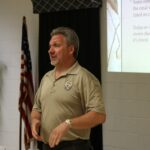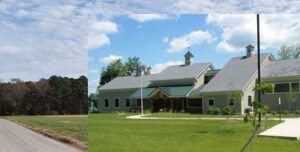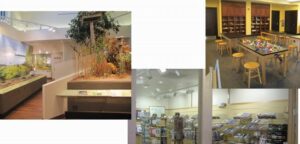
Chris Lowie, GDWNWR Manager
For our March monthly chapter dinner meeting, guest speaker Chris Lowie, manager of the Great Dismal Swamp National Wildlife Refuge (GDSNWR), gave us two interesting presentations. The first one was on the history of the GDSNWR and the second one was on the status of the GDSNWR Jericho Ditch Trailhead Enhancement project.

Chris first spoke about the communities that thrived in the western high ridge areas of the million acre swamp from the 1700s through the mid-1800s and their interactions with the timber, rail, and canal building industries. He spoke about how the swamp was drained for farming and for logging of white cedar and bald cypress going all the way back to George Washington’s involvement in colonial times.
He spoke about the communities of maroons who lived in the swamp and enumerated the literary works of Longfellow & Stowe that focused on the lives of the maroons (and of self-emancipated slaves), and how after the civil war they began to work for, barter with, and eventually migrate away from those who were steadily encroaching upon them. Chris touched upon findings from archaeological digs by Daniel Sayers in the swamp and discussed the underground railroad and network to freedom trails and the responsibility of the GDSNWR to educate the public about their historical significance.

Mock-up of a proposed visitor center at Jericho Lane Trail Head
Chris’ next presentation concerned the Jericho Lane Trailhead Enhancement Project, which he categorized as a vision, currently in the “public scoping phase”, that if implemented will fulfill the goals first laid out in the original 2006 15-year CCP (Comprehensive Conservation Plan).

Mock-up of proposed classrooms and gift shop at Jericho Lane Trail Head
The project encompasses a multi-prong strategy involving land acquisition, donations from private business partnerships such as the recent grant from Dominion Energy, and pursuit of proposed legislation to designate the swamp as a “natural heritage area” with hoped for accompanying federal appropriation dollars. Chris’ vision encompasses an educational pavilion, outdoor trail, kiosk, gift shop, indoor and outdoor classrooms, with a connection to the city park with plenty of parking for cars and school buses.
After concluding his presentations Chris answered questions from the audience and announced upcoming volunteer opportunities at the swamp including a need to spread piles of stone dust, and the planned establishment of recurring monthly volunteer days for other such volunteer tasks. When asked about consideration for filling ditches throughout the swamp, he responded that they had just hired some new employees for fire control, and that there is just one last water control gate mechanism to be installed, and that with all the gates operational they should be able to keep the existing roadways throughout the swamp intact to facilitate maintenance yet still be able to mitigate the risk of peak fires by controlling water levels. The alternative to try and put the swamp back to its native state, he said, would not have been practical and would have involved eliminating the roadways by pushing dirt and rock/detritus back into the ditches which would not have not have restored them to their original peat consistency.
Afterwards, President Chris Ferguson thanked Chris for coming out to our chapter dinner meeting and giving us his presentations.
